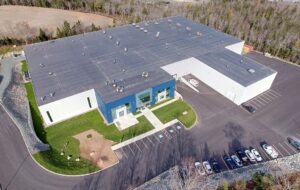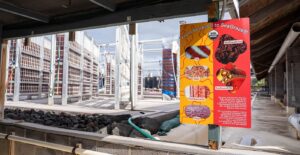On the final day of AgTech Week in New York City, a panel of local experts got together to think about how the city can embrace, promote and foster urban agriculture.
New York is one of the leading cities in the US for urban agriculture, with a plethora of initiatives from hobby community gardens to commercial rooftop farms to high-tech indoor vertical farms. But there is still a long way to go until the city provides wannabe urban growers with the support they need to make locally grown produce a permanent and significant part of the city’s food supply.
Before the panel commenced, Henry Gordon-Smith, a celebrity in New York’s urban agriculture scene and founder of consultancy and content businesses Agritecture and Blue Planet Consulting (now Agritecture Consulting), set the scene by offering some insights into how other cities in the world make a success of their urban agriculture initiatives.
In Cuba, for example, 3.2 tonnes of organic food was grown in urban farms in 2002. Individuals are incentivized economically to grow food, but there are also rules around what they can grow in each location, depending on what else is being grown nearby to ensure diversity in the food supply.
Japan’s weekend farming program brings families out of the city and into the surrounding countryside to help grow food, connecting them with the source of their food and providing them some often needed respite from city life. There are also programs to get their help at indoor grow operations too.
And in Canada, urban farmer Curtis Stone has borrowed or rented unused land to produce food at scale, making the most of untapped resources in the city, and rules around vacant real estate lots.
“How can we have our own brand and approach to urban agriculture in New York City?” he asked the audience.
What are the main challenges for urban agriculture in New York and what can the city do to alleviate them
1. Access to Land and Space
This can be a real inhibitor at the early days of a project, but also when the operator wants to scale, moving from 1,000 sq ft to 10,000 sq ft is very difficult, said Gordon-Smith.
The difficulties mainly lie in permitting and the delays inherent in the system. There is also lack of available information about the availability of space for urban farms.
Gordon-Smith and Tatiana Pawlowski, a law clerk at Braverman Greenspan and expert in zoning laws, blamed permitting challenges to a lack of understanding in the department of buildings about urban agriculture. “The department does not know how to handle an application for an urban farm. The zoning code itself is very hard to read and it’s very long. It hasn’t been updated since 1962 and the phrase urban agriculture doesn’t exist! There is some brief talk about raised truck beds and community gardens, but the law is very silent on what exactly can and can’t be done.”
Gordon-Smith added: “There is a lot of interpretation of code needed before permits can be awarded, but for operations, timing is critical to get investment as investors won’t support a project if you can’t secure a space.”
There is also a lack of concrete, and available data and information about where vacant spaces might be and how they’re utilized, or not.
“People might not know that technically farming is allowed in commercial and industrial districts,” Pawlowski said.
What Can NYC Do?
Create a well-organized, centralized place for all data and information about finding and securing space in New York that’s readily accessible.
“Modernize and organize the information available so it’s readily accessible for urban farmers, particularly small-scale scale community residents,” said Tatiana.
None of the panelists suggested this outright, but it sounds like the city could do with updating its zoning laws too!
Rafael Espinal, council member for Bushwick and East New York, agreed that urban farming initiatives were struggling to get seed funding they need because investors are afraid to invest in a city which has “not yet taken a leading role in recognizing the work that’s being done in this area.” He added that he has introduced a bill to “force the city to sit down and take a year to figure out what challenges we’re seeing for urban agriculture in terms of zoning or incentives as the city must get engaged at that level.”
2. Access to Basic Talent
Finding entry level talent, with some training in food safety and other relevant skills, is very challenging, according to all the panel members. It also represents a significant portion of an urban operation’s cost base.
What Can NYC Do?
Gordon Smith suggested that the city could develop a training program to help develop a diverse skillset among potential workers to strengthen the urban ag industry, but that there might need to be a financial incentive attached to it, particularly as labor is one of the leading operational costs of urban farming.
Alex Highstein, corporate development at AeroFarms, which is based in New Jersey, said New Jersey has some initiatives like this. “We work with the New Jersey Economic Development Authority. They have a program called Grow NJ which gives us tax incentives for hiring, and we’re also working with the city of Newark to source labor from fantastic places like the veterans program, and the re-entry program. They help train them, particularly where there are big gaps in knowledge such as around food safety.”
3. Lack of Awareness About Benefits of Local Food
Governments do not put local food first, which limits the ability to promote urban agriculture among the population to bring new talent and expertise to the sector.
Highstein agreed that people in New York “often lack a connection to what they’re eating; if we could spread the idea that this food was grown the next street over, those people would value their food more.”
What Can NYC Do?
Work with industry, incubators, and farms to spread those ideas around the importance and value of locally grown food.
“We need more carrot to get groups involved and excited about promoting urban agriculture to help it accelerate,” said Gordon-Smith.
4. Energy Costs and Carbon Footprint
There is a certain amount of resistance to indoor farming from some quarters of the city, namely around the high use of electricity to light and heat indoor farming facilities, and therefore the potential for added pollution. Developments in LED lighting are aiming to increase efficiency, but it’s a significant cost-base, economically and carbon emissions-wise.
Council member Espinal said: “We get lots of emails from people who are against expanding urban ag as they say it will require more power and create more plumes. There is not enough green energy produced, pushing reactors to create more power to feed indoor farm lighting.”
What Can NYC Do?
“We need to continue pushing for ’80×50′, which is a New York pledge to reduce greenhouse gas emissions by 80% by 2050,” said Espinal. “But to do this the city needs to change the grids to accept solar and wind energy.”
Highstein also suggested incorporating hydroelectrical energy.
Panelists argued that protesters also need to be better educated about the environmental benefits of urban agriculture, something the local government could help with.
“People forget about the benefits of outdoor rooftop farming and the amazing effect it has on mitigating the heat island effect, where black tar rooftops create heat, requiring more energy to cool buildings down,” said Pawlowski. A green roof can bring temperatures down by a couple of degrees, which is significant, and not only fits with the 80×50 plan but is also good for air quality.”
Harrison Hillier, hydroponics manager at Teens For Food Justice said that just looking at energy consumption was only part of the broader picture, pointing to the food security indoor operations can bring in the face of natural disasters, and the reduction in the use of harmful chemicals and pollutants causing negative ecological impacts across the country.
Image credit: Shutterstock




